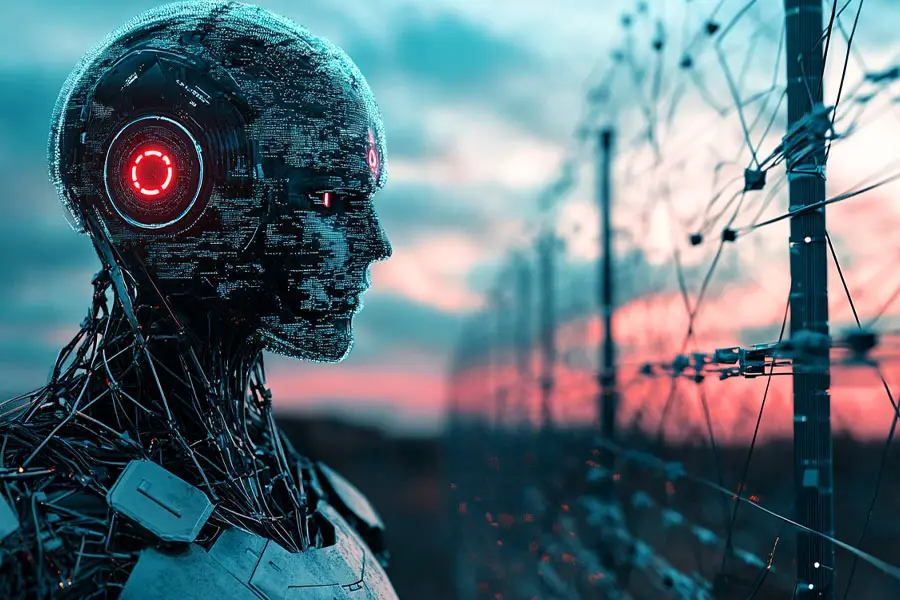These days, artificial intelligence (AI) is vital to national security. It improves the collection of intelligence, fortifies cybersecurity, facilitates decision-making, and even maximizes defense tactics. AI is used by governments and organizations all around the world to keep ahead of threats and safeguard their citizens. A closer look at how AI is changing national security is provided here.
1. Intelligence Gathering and Analysis
AI improves intelligence collection by enabling security organizations to do previously unheard-of levels of data analysis. AI finds trends, detects threats, and monitors anomalous activity by analyzing enormous volumes of data from many sources.
- Real-Time Data Analysis: AI algorithms sift through real-time data from satellite images, social media, and communication networks. Analysts gain immediate insights into emerging threats, improving response times.
- Predictive Analysis: Real-time data from communication networks, social media, and satellite photos is sorted by AI algorithms. Response times are accelerated as analysts obtain instant insights into new threats.
2. Enhanced Cybersecurity
The foundation of national security is cybersecurity. AI fortifies cyber defenses, identifies intrusions, and combats cyberattacks with unparalleled precision and speed.
- Threat Detection: Data breaches are less likely when suspicious activity is detected and blocked by AI-powered solutions. Over time, machine learning algorithms become more successful by learning from past attacks.
- Automated Response: AI automatically neutralizes cyber threats and stops attacks before they have a chance to spread. This automation protects critical data and minimizes human error.
- Data Encryption and Protection: By improving data encryption, artificial intelligence makes it more difficult for hackers to obtain private data. These cutting-edge methods are employed by national security organizations to safeguard sensitive information and vital infrastructure.
3. Drone and Surveillance Operations
Drone technology has been transformed by AI, increasing the effectiveness of surveillance. AI-enabled drones carry out a variety of duties, including intelligence collection, movement tracking, and border surveillance.
- Autonomous Drones: Drones can now function independently thanks to AI, which eliminates the need for human control. These drones collect important intelligence, guard restricted locations, and patrol borders.
- Image and Video Analysis: Drone-captured photos and videos are analyzed by AI systems. Because of this automation, suspicious activity can be identified more quickly, enabling quicker reactions to possible threats.notification of suspicious activity, allowing faster responses to potential threats.
- Facial and Object Recognition: Artificial intelligence (AI)-powered surveillance systems recognize faces and objects to identify suspicious activity or people of interest. Security organizations can identify dangers before they become more serious thanks to this technology.
4. Decision Support Systems
Decisions must be made quickly and intelligently for national security. Decision support systems (DSS) driven by AI help leaders by offering precise, up-to-date insights.
- Real-Time Data Processing: DSS provides decision-makers with meaningful insights after analyzing vast volumes of data. Threats are more clearly visible to leaders, enabling them to act quickly and decisively.
- Risk Assessment: AI-based DSS helps organizations decide on the optimal course of action by assessing the possible effects of different actions. These technologies save lives by predicting results and avoiding expensive errors.
- Simulations and Scenarios: AI models mimic diverse situations, illustrating the possible outcomes of various actions. By assisting leaders in weighing the advantages and disadvantages, these simulations enhance national security plans.
5. Border Security and Immigration Control
AI improves and automates surveillance, strengthening border security. AI helps with identity verification and threat detection at border crossings with its sophisticated recognition tools.
- Automated Identity Verification: Wait times at border checks are decreased by AI systems that scan passports, visas, and other paperwork. This expedites processing and makes it easier to spot counterfeit documents.
- Biometric scanning: biometric information, such as fingerprints and facial recognition, aids in precise identity verification. Watchlists and this data are cross-checked by AI systems, which notify authorities of people who have been flagged.
- Anomaly Detection: Unusual patterns of behavior, including abrupt, extensive movement close to borders, are detected by AI. This early alert aids law enforcement in stopping unauthorized crossings and spotting questionable activity.
6. AI in Military and Defense Strategy
AI is revolutionizing military operations through resource optimization, equipment improvement, and defensive strategy assistance.
- Autonomous Vehicles: Autonomous vehicles with artificial intelligence (AI), such as aerial drones and unmanned ground vehicles (UGVs), help with hazardous military missions. These vehicles support missions, patrol, and collect intelligence with little assistance from humans.
- Intelligent Weapon Systems: AI improves the precision and accuracy of weapons. The ability of smart weaponry to make snap decisions improves targeting and lowers collateral damage.
- Logistics and Supply Chain: AI streamlines supply chain operations, guaranteeing that military supplies get to their destinations quickly. By streamlining procedures, this technology keeps defense forces ready for any task.
7. Counter-Terrorism Efforts
AI is essential to the fight against terrorism. It assists organizations in recognizing, tracking, and thwarting any dangers before they become more serious.
- Behavior Analysis: AI looks for signs of terrorist plotting by analyzing communication, travel, and other activity patterns. AI aids in the prediction and prevention of terrorist acts by examining patterns of behavior.
- Social Media Monitoring: Social media platforms are searched by AI systems for suspicious activity and coded language. Through the identification of potential threats, agencies can prevent crises and safeguard public safety.
- Real-Time Alerts: Real-time notifications from AI systems enable security forces to react quickly to threats. These notifications keep law enforcement aware and prepared to respond quickly.
Conclusion
By enhancing intelligence, cybersecurity, surveillance, and other areas, artificial intelligence is changing national security. Security organizations can react more quickly, make wiser choices, and successfully protect civilians with AI. AI will continue to play a bigger part in national security as technology develops, providing fresh approaches to ensuring resilience and public safety in a complex, changing world.

